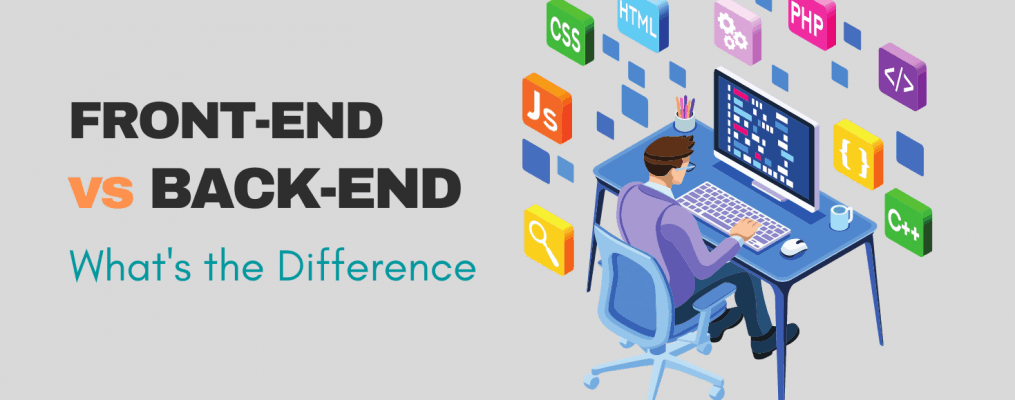Frontend vs. Backend Development – What’s the Difference?

Web Design & Development
If you’re new to custom web development, you must have heard the terms “frontend” and “backend” quite a lot. But what exactly is meant by frontend vs. backend development? While these two forms of programming are distinct, they’re also like two sides of the same coin – one cannot exist without the other!
Both frontend and backend development play a vital role in creating and maintaining a well-functional website or application. However, they are very different from each other. They use different frameworks and programming languages, and each deals with various aspects of web development.
Essentially, the primary difference between frontend and backend development is that the former handles the client-side (what we see on the screen, i.e., the graphical user interface of a website), and the latter deals with the server-side (what works behind the scenes to deliver information to end-users). Frontend refers to how a website looks, whereas backend means how it works.
Let’s compare frontend vs. backend development in detail and analyze the differences between the two to understand what each form of programming does.
Highlights
- What is Front End Development?
- What is a Front End Web Developer?
- What Does a Front End Developer Do?
- Front End Developer Skills
- Front End Technologies
- Front End Development Services
- How to Hire Front End Developer?
- What is Back End Development?
- What is a Back End Developer?
- What Does a Back End Developer Do?
- Back End Developer Skills
- Backend Technologies
- Back End Development Services
- How to Hire Backend Developer?
- What is Full Stack Developer?
- The Bottom Line
What is Front End Development?
The frontend part of a website is what you can see and interact with on the browser. Sometimes also coined as “client-side,” it comprises everything that you can see, touch and experience directly, including:
- Layout/design
- Text
- Images
- Internal links
- Buttons
- Animations
- Navigation
Frontend web development is all about developing the graphical user interface of a website, so users can view and interact with it to perform specific tasks. It involves programming the different surface-level site elements and deals to ensure your website or application looks like it should. Frontend development is referred to as the “client-side” of development as it focuses on what clients (users) see and interact with.
What is a Front End Web Developer?
A front end web developer is a web development professional who codes and constructs the visual elements of a website or application. They analyze code, design, and debug websites and applications to ensure a seamless user experience. In other words, front end web developers take care of the website’s look, feel, and design through coding and front-end programming languages, such as HTML5, CSS3, and JavaScript.
The role of the frontend developer has evolved over the past few years. Some professionals who specialize in specific front-end languages, such as JavaScript, are also considered front-end developers. Others may have intermediate to advanced JavaScript skills and experience in command-line tools and frameworks, such as Angular and React.
What Does a Front End Developer Do?
A front end developer may or may not have experience with creating designs. Most front end developers work from a web designer’s mock-ups. They usually take the visual designs from UI and UX designers and bring to life the visual elements of a website through programming. They also need to collaborate with web designers to ensure the website runs smoothly and functions well for the user.
One of the many ways front end developers can use their skills is to create a static website containing HTML pages with fixed content displayed in a web browser exactly as it is stored. To make a static web page dynamic, the front end developers will need to have a good rapport with backend developers who keep the information in a database and make it available to users from the server.
Front End Developer Skills
Front end developers need a mix of both the creative side and technical aspects of web development. Not only do you need soft skills such as creativity and a problem-solving attitude, but also you have to be well-versed with programming staples like HTML5, CSS3, and JavaScript.
On the soft/non-tech skills side, a front end developer needs to have the following skills:
- Creativity
- Strong visual sense
- Problem-solving attitude
- Growth mindset
- Teamwork and group collaboration
- Excellent communication skills
And when it comes to technical abilities, a front end developer should master the following coding-related hard skills:
- HTML5, CSS3, and JavaScript/jQuery
- CSS and JavaScript frameworks and libraries
- CSS preprocessing and AJAX
- Responsive web design
- Cross-browser compatibility/browser developer tools
- Content management systems (CMSes)
- Testing and debugging
- Version control systems (Git)
- Command-line tools and APIs
- Web performance (image optimization, CSS and JS minification, Grunt and gulp)
- Basic knowledge of server-side rendering/scripting
Front End Technologies
Front end developers use various web development technologies to bring the visual elements to life and create a first-class user experience. The front end technologies in web development can be categorized as:
#Front End Development Languages
Anyone can learn to code and become a front end web developer by learning a few programming languages. The three coding languages that lay the foundation of front end web development are:
- HTML (Hypertext Markup Language): the structural backbone of a website.
- CSS (Cascading Style Sheets): a styling language that controls the presentation aspect of the visual elements.
- JavaScript: an event-based imperative programming language used to enhance the interaction of a website with the user.
Some other languages used in front end web development are:
- Swift: an intuitive programming language for iOS.
- Kotlin: a statically typed, cross-platform, general-purpose programming language for Android.
- TypeScript: a strict syntactical superset of JavaScript designed to build large applications.
- Elm: an event-driven, strongly typed programming language for declaratively creating web browser-based graphical user interfaces.
- WebAssembly: the only alternative to JavaScript for running code in web browsers.
#Front End Development Frameworks
To reduce busywork and speed up the development process, front end specialists often use frameworks. Usually powered by JavaScript or Java, frameworks are skeletons of pre-written code, eliminating writing everything from scratch. Some popular frameworks for front end web development are:
- Angular: a TypeScript-based front-end framework for building mobile and desktop web applications.
- React Native: an open-source JavaScript framework for building native apps for Android and iOS.
- Vue: the progressive JavaScript framework for building user interfaces and single-page applications.
- Ember: an open-source JavaScript framework for creating scalable single-page web applications.
- Bootstrap: the most popular open-source CSS framework for responsive, mobile-first front-end web development.
- Foundation: The most advanced front-end framework for building highly responsive websites.
#Front End Development Libraries
When front end developers want more freedom, they take advantage of libraries. Libraries are specific files containing pre-written code that front end experts can plug into their codebase. Some popular front end development libraries include:
- React
- Backbone
- jQuery
- LESS
- Lodash
- Redux
#Front End Development Tools
Front end specialists use several tools and platforms to develop the front end of a website, including:
- WordPress
- HTML5 Boilerplate
- Joomla
- Grunt
- Drupal
- Sass
Front End Development Services
Web development professionals offer a broad range of front end development services to delight your users with stunning user interfaces. These include:
- PSD to HTML conversion
- PSD to Email conversion
- CMS theming services
- UI/UX design services
- eCommerce theming services
- An existing site to responsive conversion
- Custom JavaScript application development
- Migration to eCommerce/CMS platforms
- Option to hire dedicated front-end developers
How to Hire Front End Developer?
Based on their experience and skill level, there are three types of front end developers you can hire for your projects:
- Junior front end developers having 0-2 years of experience. They are often familiar with only one programming language or framework.
- Mid-range front end developers with work experience of 3+ years and proficiency in more than one programming language and framework.
- Senior front end developers having 5+ years of experience and expertise in developing complex, enterprise business apps. They are capable of working with almost every front end tool.
If you’re wondering how to hire front end developers, here are some simple steps you can follow:
#Write a Project Description: Determine the scope of your project and the skills you are looking for in a front-end developer.
#Post it on a Suitable Platform: Post the project description you have written to outsourcing platforms, such as Clutch, GoodFirms, IT Firms, and TopDevelopers. You can also post it on your own website!
#Shortlist and Interview: Once the proposals start rolling in, shortlist the candidates you want to interview. Ask the following questions to professionals you’re interviewing to ensure you hire the right candidate for your project:
- What are the languages and frameworks you’re proficient in?
- Do you like to work independently or in a team, and why?
- How many projects have you worked on?
- What were your responsibilities in past projects?
- What are some of your favorite front end tools, and why?
- Are you a learner? How do you improve your front-end developer skills?
- How do you typically tackle the testing of your code?
- What are the biggest challenges you face during front end development? How do you overcome them?
Following these three steps, you can hire specific types of front-end developers to work on your projects.
What is Back End Development?
The back end, also called the “server-side,” is the part of the website that users can’t see and interact with. While front end development is about crafting a website or application’s graphical user interface, back end development involves dictating how the system works. In other words, it includes everything that happens “behind the scenes” and is invisible to end-users. This type of web development usually consists of three parts:
- Application code
- Server
- Database
- Middleware
- APIs
Unlike the front end, the back end deals with all the complex grimy tasks that run on the server-side, such as data storage and organization, and communicates with the front end to ensure the system functions smoothly.
What is a Back End Developer?
Web development professionals who deal with the backend part of the website are called back end developers or programmers. They write code that communicates the database information to the browser. Their other responsibilities include making updates and changes and monitoring the functionality of a website. Ideally, anything you can’t see with the eye, such as databases, servers, and cloud services, is the work of back end developers.
Back end developers play a vital role in developing a website or application, and their role is highly collaborative compared to front end professionals. They tend to devote more time figuring out core functional logic and implementing algorithms than front end developers to ensure the website’s proper functioning. In short, back end web developers write non-user interface code to make sure everything on the front end side works fine.
What Does a Back End Developer Do?
The role of a back end developer in web development can be understood with the example of a static website, which is often used to showcase professional profiles or portfolios. The content of a static website doesn’t really change much as the front end contains all of the necessary information that determines what appears on the web page.
However, if you want to make your website interactive, for instance, you want to sell something through your website, you’ll need help from a back end developer who understands what’s going on behind the scenes of your website. The back end developer will turn your static site into a dynamic web application of which content changes based on users’ input or what’s in its database.
Thus, back end web developers work on tasks like:
- Back end logic
- Database management
- Communication between applications and servers through APIs
- Accessibility and security policy compliance
- Troubleshooting and debugging web applications
Back-end web developers need to work closely with front end professionals to create and maintain websites properly. This enables smooth communication between servers, databases, and applications, ensuring smooth delivery of the final product at the front end.
Back End Developer Skills
A back end developer must have an eye for detail and a strong passion for developing the back end architecture of the website. They should be able to work effectively with front end developers and have soft skills in critical thinking and effective communication. The traits to look for when hiring a back end web developer are:
- Critical thinking.
- Proficiency in PHP, JavaScript, Python, and Linux server handling.
- Experience in working with MySQL, MongoDB, Redis, and Elasticsearch.
- Familiarity with back end frameworks, like Laravel and Django.
- Experience in basic system design and architecture.
- Familiarity with full-stack development.
- In-depth knowledge of Java Design Patterns.
- Familiarity with behind-the-scenes technologies, such as databases and servers.
- Strong knowledge of REST, JSON, Web services, and XML processing.
- Knowledge of testing and debugging, including automated testing.
- Familiarity with code versioning tools, such as Git.
Backend Technologies
Along with being proficient in front end languages such as HTML5 and CSS3, back end developers use various technologies, tools, and frameworks to handle the back end aspects of a website or application. Backend technologies for web development can be categorized as:
#Back End Developer Languages
As you might expect, back end web development draws upon a slightly different set of programming languages than front end web development. The widely used back end developer programming languages are:
Additionally, back end developers need to be familiar with MySQL, SQL Server, MongoDB, and Oracle databases.
#Backend Development Frameworks
Back end developers often use frameworks to simplify the web development process and automate some back end tasks. The most popular back end development frameworks include:
- Laravel
- Django
- Ruby on Rails
- Flask
- .Net
- Express
- Spring
It is nearly impossible to incorporate interactive features, such as infinite scrolling, into a website without these frameworks.
#Backend Libraries
Back end developers also use some libraries for a more flexible and easier development process. Some most popular back end libraries include:
- TensorFlow
- FastApi
- Pillow
#Back End Web Development Tools
Back end developers also use software stacks that include various languages, frameworks, programming APIs, web servers, operating systems, and more. The most popular back end stacks include:
- .NET (PHP, Python, JavaScript, Java, CSS, SQL, and DevOps)
- MEAN (MongoDB, Express.js, Angular, and Node.js)
- LAMP (Linux OS, the Apache HTTP Server, the MySQL, and PHP)
Back End Development Services
Web development professionals offer a broad range of back end development services, including:
- API development and management
- Third-party Integration
- Database design
- Custom backend development
- Application admin development
- Backend CRM development
- Cloud deployment
How to Hire Backend Developer?
Like the case of front end developers, the level of back-end developers’ expertise can be divided into three categories: junior, middle, and senior. Also, the process of hiring a backend developer contains three steps:
- Define your project scope and the skills you are looking for in a back end developer.
- Post it on a suitable outsourcing platform, such as Clutch, GoodFirms, IT Firms, and TopDevelopers. You can also post it on your own website.
- Shortlist and interview the selected candidates.
To make sure you end up hiring the right back end developer, ask the following questions to professionals you’re interviewing:
- How many projects have you worked on?
- What were your responsibilities in past projects?
- What are the languages and frameworks you’re proficient in?
- Do you like to work independently or in a team, and why?
- What are some of your favorite back end tools, and why?
- Are you a learner? How do you improve your back end development skills?
- How do you typically tackle the testing of your code?
- What are the biggest challenges you face during back end development? How do you overcome them?
What is Full Stack Developer?
Web development professionals proficient in both front end and back end development are often referred to as full stack developers. They can work cross-functionally on the full “stack” of technology, i.e., both the back and front end. They’re the jack-of-all-trades of the web development world as they get the best of both fields. While some people consider full stack developers may not have the same depth of knowledge as front and back end developers, the reality is that they have a strong enough overall knowledge of both sides of web development.
The Bottom Line:-
Front-end and back-end development are two different parts of the web development process, yet they are internally connected. For a visually appealing and highly interactive website, you’ll need to hire both front-end and back-end developers. You can even go the “full-stack” path if you want to hire professionals with expertise in both areas of web development. It all depends on your requirements. Whether you need back-end, front-end, or full stack web developers, you can hire dedicated developers from iPraxa to get your project done on time and within your budget.


